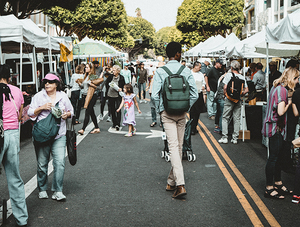How and Where to Sell Your Photography
Everyone has hobbies, and Photography is one of the most popular hobbies in the world. However, it can also be a very expensive hobby for those looking to take it seriously and create great art. High quality cameras, printing, or lighting depending on the type of work — are just a few of the likely expenses a photographer will face. Along with other smaller costs that add up over time, it quickly becomes evident that pursuing photography is not going to be cheap.
Photographers love printing their photos as it brings their work to life and gives a sense of satisfaction to see the final product of the perfect photo they worked hard to achieve. Of course, printing has costs of its own, and selling these prints can be a great way to supplement those costs and others associated with photography. Selling prints not only provides income, but also motivation from the affirmation of someone who is willing to spend their hard-earned money on a photo that you worked hard to create.
Fortunately, there are several different ways that photographers can monetize their prints and support the expenses associated with being a photographer. However, monetization can be a challenge because it requires a different skill-set than taking great photos; you need to be able to market them to the correct audience. We’re going to look at four different ways to consider when looking at selling your work, as well as a few tips to help fully utilize these outlets.
Selling your work online
The internet has opened a lot of doors for photographers, allowing them to sell their work conveniently from home. In concept, it sounds very easy – simply build a website with a portfolio and allow customers to place orders for prints they want to purchase. There are many site building services available that allow even the least tech-savvy photographers to build a great looking website. However, you’ll quickly find out that sales don’t just start rolling in because you have a website.
Not as easy as it seems
Once the website is up and running, that’s great, but how are your potential customers going to know about it? Selling online requires a lot of marketing and advertising, especially for photographers who are just starting out and don’t have an established brand or following.
Obviously marketing and advertising come with costs of their own, so trying to sell online to supplement start-up costs is going to be rough. The online market for prints is extremely saturated and competitive, and although it isn’t impossible to sell online, it isn’t as easy as it appears at first glance.
This isn’t meant to discourage you from selling prints online, as this a great option for those who already have a lot of interest in their work. It certainly doesn’t hurt to have a website even as a new photographer, but you shouldn’t rely on that as your only means of monetization or expect it to propel your hobby into a full-time career all on its own. At the very least, having something established allows you to refer customers obtained through other means back to the website for further sales and exposure.
Selling your prints locally
Although selling online seems like it would be the best way to start out, the truth is that selling prints locally has always been the best way for an aspiring photographer to get started. As previously mentioned, online photography monetization is a saturated market with thousands of others looking to do the same thing. Therefore, selling locally is much easier to get started with, since you’re likely to face much less competition and will be able to reach more potential buyers face to face.
Invest in a few prints of your best work and show them to your close friends and family at first. Make sure to ask for their honest opinions to start garnering some legitimate feedback to know what areas you need to work on – who knows, you may even get your first few sales this way if they really like your work and want to support you as a photographer.
You should also strongly consider registering for local craft shows or green market events. These usually take place on the weekends and will give you more opportunities not only for sales, but more feedback and suggestions. Attending these events is a small commitment that can really pay off and allow you to start establishing a following of people who are interested in your photography. On top of that, you can use these events to promote your website and start growing your online business as well.

Selling your artwork at local craft shows and green market events can be a great way to receive feedback and also avoid the extremely competitive online market.
Selling your prints in galleries
Art galleries are another potential monetization option, but galleries are not quite as lucrative as it seems. Between commission, exclusivity agreements, and the top-tier competition – galleries aren’t a great option for those starting out. Still, it’s good to keep them in mind as you continue to grow as a photographer as they do offer some benefits.
A big plus to having your work in a gallery is that you can use that as leverage for your other work. Saying that you have art featured somewhere makes whatever you’re selling more enticing to potential buyers.
Choosing the right galleries
If you choose to pursue galleries to monetize your work, there are a few things you should know beforehand. First, you won’t receive 100% of the sale as the gallery will take a chunk of that sale as commission typically ranging from 40-60% depending on the gallery. Typically, the more prestigious the gallery is, the higher commission they will take, but this isn’t always true. Your work will likely be marked up by at least 100% as well, which leaves more room for commission but making the sale might be more difficult.
Prints do not usually sell that quickly in a gallery, so to start seeing a decent amount of income you’ll need several prints in multiple galleries. Keep in mind that most galleries require an exclusivity agreement which prevents you from selling that particular piece anywhere else. This is one reason new photographers may want to avoid galleries at first, especially if they don’t have a large selection of prints to be signing away the rights to sell.

Selling your artwork in a gallery can add to your credibility but comes at a cost.
Selling at Art Shows
Somewhere between art galleries and local craft fairs you have art shows, which are a fantastic way to promote your work. Although they are not as prestigious as art galleries, they come with a lot less restrictions and more opportunities for new photographers.
Art shows attract an audience specifically looking to buy unique works of art. The people who attend these shows are often ready, willing, and able to buy – opposed to galleries where there may be a lot more people just coming to look.
Collect a deposit
Art purchases are often very impulsive, so you want to avoid anything that could impede a potential sale. For example, someone may be interested in a piece which you don’t have any more prints available at the show. Encourage them to make a deposit and give them clear terms as far as when they’ll be delivered their print. It is unlikely they’ll come back and make the purchase later, so you want to secure the sale right away.
Offering additional incentives is a great way to close on a sale, since the customer sees this as a special opportunity to get a good deal on a unique piece of art. Taking a small percentage off the purchase price and/or offering free shipping can be enough to make up for the time they’ll have to wait to display their new decoration.
Know your audience
Now that we’ve covered four different outlets for selling your work, let’s go over a few ways that you can maximize your sales through these outlets. Perhaps the most important thing you can do is understand who your prospective buyers are and appeal to them accordingly.
Craft fairs vs Art shows
If you are displaying your work at a local craft fair or green market, you likely won’t find customers willing to spend hundreds of dollars on large pieces of luxury art. Instead, you should focus on marketing smaller prints that are more affordable. Using smaller prints also gives you more space to display a variety of artwork instead of just a few luxury pieces. You can still provide options to buy larger prints just in-case you find a buyer with deep pockets at one of these events, just be sure to let them know about lead times and deposit requirements.
You should take a different approach when selling your work at an art show, since this draws a different type of audience. These buyers are much more likely to buy a large piece of art, so you should have larger prints on display. Seeing a 40×60, 48×72, or 48×96 print on display allows them to better visualize how it will look in their home, rather than a small print that doesn’t show the true detail of the full-size print.
Keep in mind you don’t necessarily need full-size prints of every piece of work on display; having at least one to show for scaling purposes is very helpful to prospective buyers. Just make sure they are made aware that any print can be ordered as the larger size you have displayed.
Location is key
Another component of knowing your audience is understanding the location and presenting art that compliments the area you’re selling in. Photography that showcases waves in the ocean, underwater shots, or ocean sunsets will likely sell better in a town right on the shoreline. That’s not to say other prints won’t sell at all — but selling location specific prints can be a great way to boost sales.
The same goes for a major city skyline or somewhere with a historic landmark like a famous bridge or a lighthouse. This can ring especially true if this is an area that attracts a lot of tourists, as people often buy artwork from places they’ve visited to help commemorate the experience.
Learn from others and innovate
There are many photographers out there, so it is important you do things to make your work unique. A great way to start is by simply looking at your competition and getting a feel for what they’re doing. This is helpful for new photographers to understand what kind of sizes to offer and what kind of pricing to list, as well as what type of art seems to be selling to a particular audience. You don’t want to copy your competition, but you can use their showcase as a template to build yours while thinking of ways to do it even better.
A lot of artists offer similar types of work and mounting options and rely on their photo to be the enticing factor to make sales over another artist. By taking it a step further and offering a variety of mounting options or something more unique like 3D layered prints and custom shapes, you can really stand out from your competition and entice potential buyers.
Innovation is a huge part of being a successful artist, so the more creative you can be will increase the chance your art will be noticed.
Be flexible
You may encounter a customer who is looking for a custom piece of art, and these can potentially be your best customers. Don’t take it as an insult – it’s not that they think they know better than you, but they do know what they want. Offering an in-home consultation to see the layout and wall sizes can show your prospective buyers that you are serious about helping them get exactly what they’re looking for to add to their home.
Mockups are a great tool to use to help a buyer visualize what the art will look like on their wall, which can greatly increase the likelihood of making a sale. Services like our visual maker tool are a great way to put theses mockups together quickly and display them to your customers.
Collect e-mails and promote on social media
A wonderful way to gain recurring customers is through e-mail and social media, and this is one the biggest missed opportunities that a lot of photographers fail to capitalize on. E-mail lists are extremely valuable in today’s age for any type of business, and photography is not excluded from that list. Anyone who is willing to give out their e-mail is obviously interested in your work, so you can use this list to promote new prints or special deals you’re offering to a group of prospective buyers.
Make sure you also promote your social media pages like Facebook and Instagram and encourage your buyers to follow you for updates on your latest work. Social media is a huge platform for business, so anyone who isn’t utilizing it for their photography is really missing out. It’s also great for redirecting traffic to your website and getting some online sales rolling. Whenever you make a sale, encourage buyers to sign-up for your e-mail list and follow your social media as well.
Having a giveaway is one way to entice interested customers into signing up for your e-mail list. Offering a chance at an inexpensive 8×12 or 11×14 print in exchange for simply liking and sharing your social media page or writing down an e-mail address is an offer most people won’t pass up if they like your art. If these leads end up in a few sales, you’ve already recouped the costs of the giveaway and now you have a growing list of potential recurring customers.
Exposure is everything
Getting people to see your work is the most important part of growing a new photography business. You can have some of the greatest art on earth, but if nobody sees it you aren’t going to make any money. This can be one of the most challenging aspects of the industry for some artists unfortunately, but anyone can do it with enough hard work and dedication.
One way for those just starting out to gain some exposure is by working with local businesses and seeing if they would be interested in displaying your art. It is a mutually beneficial idea as it gives the artist exposure and gives businesses unique art on their walls at no cost. Just make sure you’re displaying art somewhere that make sense to do so, such as a coffee shop, juice bar, or restaurant that displays other pieces of art.
Remember to be smart with the negotiations as well, make sure you and the establishment agree on the terms and always reserve the right to move your art at any time. Another option is to offer commission and allow the business to sell the art for you if anyone happens to be interested in making a purchase.
Be prepared to put in the work
We’ve covered a lot of information with a lot to unpack, but this should help you have a better understanding of how to promote and monetize your photography. Regardless of how you want to go about selling your art, you need to be prepared to put in a lot of work to truly be successful. Don’t expect overnight success, and don’t get discouraged if you aren’t seeing progress as quickly as you hoped. Keep building your audience and improving your art – and eventually you’ll start to reap the rewards.





